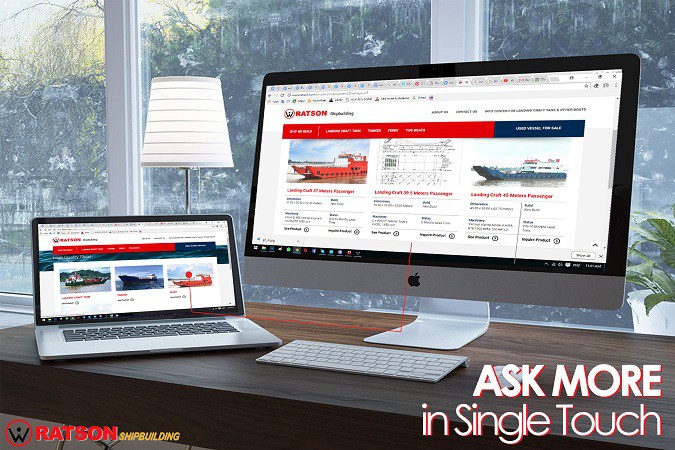
The purchasing process for many vessels might be different for every shipyard, especially if there is broker involved. However, most of the shipyards will have the same basic idea to create their standard operating procedure. There is a different procedure for purchasing a used vessel or building a new vessel. In this article, we will narrow it down to discuss only the procedure to purchase a new building vessel.
There are several steps and procedure to purchase the new building vessel. Below is the procedure as well as the explanation for each step that Ratson use to serve their clients with.
1. Finding Your Best Suited Shipbuilding Partner
First, the buyer will need to search and find the best-suited shipbuilding partner for them. There are several ways to find the potential partner. First, the contact can be obtained from their acquaintances, from friends or other connection from their relatives. Second, the contact can be obtained from website search by entering the shipyard's website. Third, the contacts can be obtained from social media like Facebook, LinkedIn, Twitter, Google Business, and many others. Fourth, the contact can be obtained from the email if the shipyard has previously in touch with the clients. Fifth, the contacts can be obtained through a broker. In the case of Ratson shipbuilding, you can find us in each of those channels.
2. Send Your Inquiry
After finding the potential shipbuilding partner, the buyer needs to contact the shipyard and tell them their inquiry Through one of the communication channel available.
3. Confirming Request and Price Indication
Once the shipyard has received the buyer inquiry, the shipyard will confirm whether they have the capacity to fulfill the order or reject the request. Before continuing the process, usually, the shipyard would like to confirm the platform that is going to be used as the communication platform. Ratson usually requests to use email as the platform so that it can be stored as Ratson database. At this step, the shipyard will try to get as much information as possible to asses the possibility to accept the request. Starting with the type of vessel, the dimension of the vessel, tonnage capacity, usage of the vessel, minimum speed required, delivery time, etc. Furthermore, the shipyard will give the price indication using their list of standard specification that has the most similar specification as the buyer request. At this step, both parties, the buyer, and shipyard will qualify each other to decide can they move forward to the next step.
4. Design Discussion and Price Indication
Once both parties have agreed to move to the next phase, the shipyard will start to make the design of the vessel. Ratson Shipbuilding believes that design is part of their investment, therefore Ratson never charges anything for the first design together with the modification. Usually, it takes 1 week to finish the rough design of the vessel without the details of the structure. After discussion and several revisions, the shipyard will calculate the price and give the quotation to the buyer.
5. Inspection and Negotiation
If the price and the design are agreed by both parties, the buyer will have to inspect the shipyard to see the credibility of the shipyards as well as meeting face to face with the person in charge to communicating the inquiry or other things that cannot be communicated through email. The negotiation can include topics such as design revision, delivery time arrangement, payment terms & schedule, etc. If the design is not suitable, repeat the procedure number 4.
6. Down Payment and Building Process
After the negotiation process, the building process will start as soon as the down payment is paid. The shipyard will give a progress report as the building process started. Usually, the buyer will have a representative or owner surveyor that stays or inspecting the shipyard periodically to check the credibility of the reports. In addition, the quality of the building process will be inspected by the agreed third parties (Class: Local/ IACS).
7. Sea Trial and Permission Process
After the vessel is finished to be build, the shipyard will do all the test to ensure that the vessel is ready to sail and processing the permission to sail with the harbourmaster. If there is a mistake or a leakage, the shipyard will do the repair and repeat the sea trial process. After all the documents ready, the vessel will be ready to sail.
8. Delivery
After the vessel ready for delivery, the shipyard will help to arrange the crew management if the buyer doesn't have prepared one. The buyer will have to complete the payment before the delivery of the vessel.
Dredgers are important machines used for excavation and land reclamation in water bodies. They come in different shapes, sizes, and types, depending on the specific purpose they are designed for. I....
Pilot boats play a vital role in ensuring the safety and efficiency of maritime transportation. These boats are designed to transport pilots to and from ships that require their expertise in navig....
Self-propelled barges are vessels that are designed to transport large quantities of cargo on inland waterways. These barges are propelled by their own engines, making them highly efficient and cos....
Barge/ Dumb Barge A barge is a flat-bottomed boat that is designed to transport goods or people on inland waterways or near-shore locations. Dumb barges, also known as unpowered barges, are t....